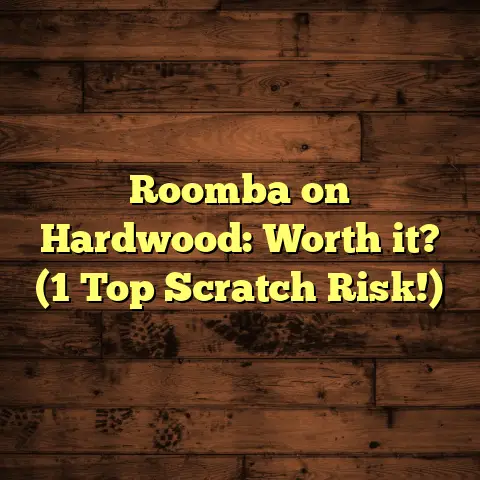Vinyl Over Tile: Good Idea? (2 Subfloor Sins!)
(2 Subfloor Sins You MUST Avoid!)
Let’s be honest, who hasn’t stared at their outdated, worn-out floors and dreamed of a quick, affordable makeover?I know I have!
Maybe you’re renting and want to personalize your space without breaking the bank.
Or perhaps you’re a homeowner on a budget, looking for a cost-effective way to breathe new life into your kitchen, bathroom, or basement.
That’s where vinyl flooring comes in, right? It’s trendy, it’s affordable, and the promise of a DIY-friendly installation over existing tile is incredibly alluring. I get it!
The market is flooded with options: luxury vinyl planks (LVP), vinyl sheets, tiles… the choices are endless!
And with so much information (and misinformation) out there, it’s easy to feel confident – maybe too confident – about slapping some vinyl over that old tile.
But hold on a second.
Before you grab your utility knife and start unrolling that vinyl, let’s have an honest conversation.
As a flooring contractor with years of experience, I’ve seen it all.
And I’m here to tell you that while vinyl over tile can work, it’s not always the slam-dunk solution it seems to be.
In fact, skipping some crucial steps can lead to some serious headaches down the road. So, let’s dive in and explore the potential pitfalls, shall we?
Section 1: The Irresistible Appeal of Vinyl Flooring
Okay, let’s face it: vinyl flooring is having a moment.
And for good reason! It’s become a go-to choice for homeowners seeking an affordable and stylish upgrade.
But what exactly makes it so popular?
Well, for starters, vinyl’s aesthetic versatility is a huge draw.
You can find vinyl that mimics the look of hardwood, stone, ceramic tile, and even concrete.
The possibilities are practically endless!
And then there’s the affordability factor.
Compared to real hardwood or stone, vinyl is significantly cheaper, making it a budget-friendly option for many homeowners.
According to recent market analysis, the global vinyl flooring market was valued at over $35 billion in 2023 and is projected to continue growing in the coming years. (Source: Grand View Research)
That’s a lot of vinyl!
What’s driving this growth?
A big part of it is the ease of installation.
Many vinyl products are designed for DIY installation, with click-lock systems or peel-and-stick backing that make the process relatively straightforward.
But let’s talk about the different types of vinyl flooring, because that’s important too!
-
Luxury Vinyl Planks (LVP): These are designed to mimic hardwood planks and come in a variety of widths, lengths, and textures. They’re known for their durability and water resistance.
-
Vinyl Sheets: These come in large rolls and are ideal for covering entire rooms, especially in areas prone to moisture, like bathrooms and kitchens.
-
Vinyl Tiles: These offer a similar look to ceramic or stone tiles but are softer underfoot and easier to install.
I remember one client, Sarah, who was ecstatic after installing LVP over her old ceramic tile in her kitchen.
She told me how much she loved the updated look and how easy it was to clean.
“It was a game-changer!” she exclaimed. “My kitchen feels brand new!”
And that’s the kind of excitement and satisfaction that many homeowners experience when they successfully install vinyl over tile.
But (and this is a big but), Sarah also did her homework.
She prepped the surface meticulously and took the time to address any potential moisture issues.
That’s the key to a successful installation.
Section 2: The Dangers of Laying Vinyl Over Tile
Okay, now for the not-so-glamorous part.
While vinyl over tile can be a viable option, it’s crucial to understand the potential pitfalls.
I like to call them “subfloor sins.”
These are the mistakes that homeowners often make when installing vinyl over tile, and they can lead to some serious problems down the road.
The longevity and performance of your new floor depends on how well you prepare.
Let’s start with the first subfloor sin: Inadequate Surface Preparation.
This is where a lot of homeowners drop the ball.
They see the smooth surface of the tile and assume it’s ready to go.
But that’s rarely the case.
Before you even think about laying vinyl, you need to ensure that the tile surface is clean, level, and free from imperfections.
That means thoroughly cleaning the tile to remove any dirt, grease, or grime.
You might even need to use a degreaser to get it really clean.
Next, you need to check for any loose or cracked tiles.
These need to be repaired or replaced before you proceed.
Even small imperfections can telegraph through the vinyl, creating an uneven surface that’s prone to wear and tear.
Grout lines are another major concern.
If they’re not properly filled, they can create dips and bumps in the vinyl, making it look uneven and unprofessional.
I’ve seen homeowners try to skip this step by simply laying the vinyl over the grout lines, but it never works out well.
The grout lines eventually show through, and the vinyl can crack or tear.
The best way to address grout lines is to fill them with a self-leveling compound.
This will create a smooth, even surface that’s perfect for vinyl installation.
I had one client, Mark, who learned this lesson the hard way.
He decided to lay vinyl over his existing tile in his basement without properly preparing the surface.
He skipped the grout filling step, and within a few months, the grout lines were clearly visible through the vinyl.
The vinyl started to crack and tear in those areas, and he ended up having to replace the entire floor.
It was a costly mistake that could have been avoided with a little extra preparation.
According to the National Wood Flooring Association (NWFA), proper subfloor preparation is essential for a successful flooring installation. (Source: NWFA Installation Guidelines)
They recommend checking the subfloor for flatness and moisture content before installing any type of flooring.
Section 3: The Second Subfloor Sin: Moisture Issues
Now let’s move on to the second subfloor sin: Ignoring Moisture Problems.
This is another big one, and it can have serious consequences if you don’t address it properly.
Moisture can seep through tiles and affect the vinyl layer above, leading to a host of problems.
The most common issue is mold and mildew growth.
If moisture is trapped between the tile and the vinyl, it can create a breeding ground for these nasty organisms.
Mold and mildew not only damage the flooring, but they can also pose serious health risks, especially for people with allergies or respiratory problems.
But moisture can also cause the vinyl to peel, bubble, or warp.
This is because the moisture can weaken the adhesive that holds the vinyl in place, causing it to detach from the tile.
So, how do you prevent moisture problems?
The first step is to test the moisture content of the tile and the subfloor beneath it.
You can use a moisture meter to get an accurate reading.
If the moisture content is too high, you’ll need to take steps to dry out the area before installing the vinyl.
This might involve using a dehumidifier, improving ventilation, or repairing any leaks that are contributing to the moisture problem.
It’s also important to consider the type of tile you’re covering.
Porous tiles, like terracotta or unglazed ceramic, are more likely to absorb moisture than non-porous tiles, like porcelain.
If you’re covering porous tiles, you might need to apply a sealant to prevent moisture from seeping through.
I remember one homeowner, Lisa, who had a nightmare experience with moisture problems.
She installed vinyl over tile in her bathroom without testing the moisture content.
Within a few months, she started to notice a musty smell in the bathroom.
She eventually discovered that mold was growing beneath the vinyl.
She had to tear out the entire floor, remediate the mold, and start over.
It was a costly and time-consuming process that could have been avoided with a simple moisture test.
According to the Environmental Protection Agency (EPA), moisture control is essential for preventing mold growth in buildings. (Source: EPA Mold Resources)
They recommend identifying and correcting any sources of moisture before installing flooring.
Section 4: Comparing the Pros and Cons
Alright, let’s step back for a moment and take a balanced look at the pros and cons of installing vinyl over tile.
On the one hand, there are some definite advantages:
-
Cost Savings: Vinyl is generally cheaper than other flooring options, and you can save even more money by installing it yourself.
-
Aesthetic Upgrades: Vinyl can instantly transform the look of a room, giving it a fresh, modern feel.
-
Ease of Installation: Many vinyl products are designed for DIY installation, making it a relatively quick and easy project.
But on the other hand, there are also some significant risks:
-
Inadequate Surface Preparation: Failing to properly prepare the tile surface can lead to uneven floors, visible grout lines, and premature wear and tear.
-
Moisture Issues: Ignoring moisture problems can result in mold and mildew growth, which can damage the flooring and pose health risks.
-
Potential for Damage: If the tile is damaged or uneven, it can telegraph through the vinyl, creating an unsightly appearance.
So, how do you weigh these pros and cons and decide whether or not vinyl over tile is the right choice for you?
Here’s a simple chart to help you visualize the comparison:
| Feature | Pros | Cons |
|---|---|---|
| Cost | Affordable, DIY-friendly | Potential for costly repairs if done incorrectly |
| Aesthetics | Wide range of styles, modern look | Imperfections in tile can show through |
| Installation | Relatively easy for DIYers | Requires meticulous surface preparation |
| Moisture Resistance | Water-resistant (some types) | Can trap moisture, leading to mold and mildew |
| Durability | Durable under normal conditions | Can be damaged by uneven surfaces or excessive moisture |
Ultimately, the decision depends on your specific situation and the factors at play in your home.
Do you have the time and patience to properly prepare the tile surface?
Are you confident that you can address any potential moisture issues?
If the answer to either of these questions is no, then you might want to consider other flooring options.
Section 5: Conclusion
We’ve covered a lot of ground in this article, and I hope you’ve gained a better understanding of the complexities of installing vinyl over tile.
The key takeaway is that while it can be a viable option, it’s not always the simple, straightforward solution it seems to be.
Addressing the two subfloor sins – inadequate surface preparation and ignoring moisture problems – is absolutely crucial for a successful installation.
Skipping these steps can lead to costly repairs, health risks, and a less-than-desirable end result.
I’ve seen too many homeowners make these mistakes and end up regretting their decision.
So, before you decide to lay vinyl over tile, I urge you to weigh your options carefully.
Consider the condition of your existing tile, your skill level, and your tolerance for risk.
If you’re not comfortable with the potential pitfalls, then you might want to consider hiring a professional flooring contractor.
They can assess your situation, identify any potential problems, and ensure that the installation is done correctly.
Ultimately, the goal is to create a beautiful, durable, and healthy floor that you can enjoy for years to come.
And that requires careful planning, meticulous preparation, and a healthy dose of realism.
Don’t let the allure of a quick and easy fix blind you to the potential risks.
Take the time to educate yourself, ask questions, and make an informed decision.
Your floors will thank you for it!
And remember, I’m always here to help. Feel free to reach out with any questions or concerns you might have.
Happy flooring!





